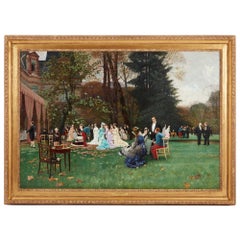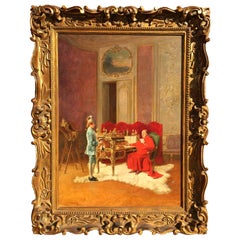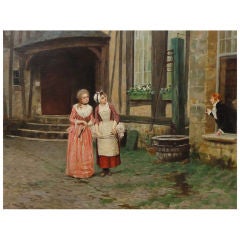C Delort
Late 19th Century Figurative Paintings
Canvas, Wood, Oil
Antique 19th Century French Rococo Paintings
Canvas, Wood
19th Century Academic Figurative Paintings
Oil
Recent Sales
Antique 1870s French Paintings
Canvas, Paint
Antique 19th Century French Paintings
Canvas
People Also Browsed
Early 20th Century European Art Nouveau Vases
Bronze
Antique Late 19th Century French Empire Revival Console Tables
Marble
Late 20th Century Italian Baroque Sterling Silver
Sterling Silver
Antique 19th Century European Neoclassical Mantel Clocks
Bronze
Antique Late 19th Century French Belle Époque Chairs
Fabric, Giltwood
21st Century and Contemporary Italian Animal Sculptures
Crystal, Gold Plate, Brass
Vintage 1940s French Art Deco Wall Lights and Sconces
Iron
Antique Early 19th Century Australian Art Deco Posters
Paper
Antique 19th Century Spanish Louis XV Fountains
Marble
Antique 19th Century French Tribal Figurative Sculptures
Iron
Vintage 1930s French Art Deco Console Tables
Marble, Steel
Vintage 1930s Swedish Art Deco Armchairs
Mahogany
Antique Late 19th Century Baroque Revival Armchairs
Velvet, Walnut
Antique Late 19th Century French Belle Époque Table Lamps
Bronze, Ormolu
20th Century Chinese Qing Armchairs
Rosewood
2010s American Art Deco Wall Lights and Sconces
Wrought Iron
Charles Edouard Edmond Delort for sale on 1stDibs
Charles Édouard Edmond Delort was a French academic painter born in Nimes, France, on February 4, 1841. He spent the early part of his life growing up in Bordeaux. At the age of 12, he entered the Naval Academy, but the strict training was not to his liking and he soon left. He met M. Duhousset, the Professor of Design at the college of Lorient, in Brittany and studied with him for a short time. It soon became clear to Delort that Duhousset’s mission was to prepare and persuade him to enter military school (L'école d'état-major). He left his studies in Brittany and headed for Paris. Delort arrived in Paris in 1859 and thanks to the recommendation of Jean-Léon Gérôme (a family friend), he entered the studio of Marc-Charles-Gabriel Gleyre, where he made rapid progress. It was during his training with Gleyre that George Pradel noted in Les Aquarellists, Paris 1883, where Delort acquired those warm, refined, yet vigorous octaves of color which we are to find at a later period in all his work. In 1862, Gérôme sailed for Egypt and Delort, seeing the opportunity for a close relationship with the master, accompanied him. With Gérôme as his mentor and guide, Delort was able to complete an important series of studies during the journey and upon returning to Paris, he entered the competition for the Prix de Rome. Delort spent the next few years in his retreat at Marlotte, where he studied and worked on his technique. In 1866, he was ready to exhibit and made his debut at the Paris Salon with his work - Daphnis and Chloe. The work was a great success and as he continued to exhibit, his popularity rose. Collectors and dealers soon learned the way to his studio in Marlotte. In 1875, he exhibited his most celebrated work The Embarkation of Manon Lescaut for Louisiana, which won him a medal. It was from this point that he seems to have devoted his career to scenes of the 18th century.




